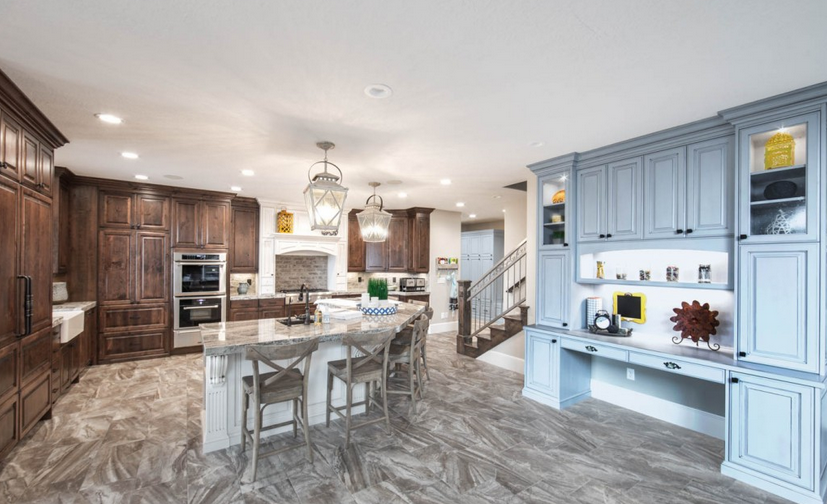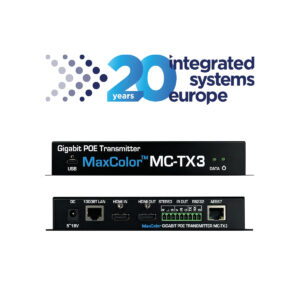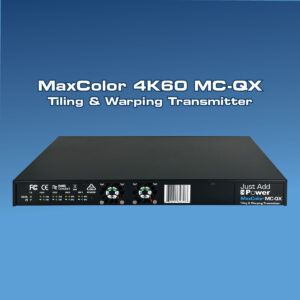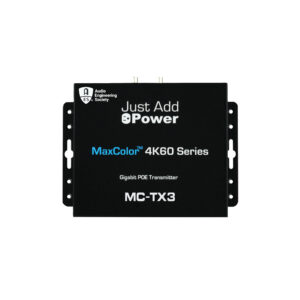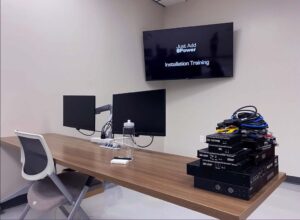
Distance Capabilities
With HDBaseT it is difficult to push a HDMI signal over Cat 5e/6 to distances greater than 100m, making it difficult to implement in estates with multiple properties and very large homes.
Because HDMI over IP is network based (uses a 1 Gb managed switch to create a HDMI matrix) it can take HDMI signals further. With a Just Add Power HDMI over IP system, you could have one Layer 3 Gigabit Managed Switch with Just Add Power transmitters and receivers in the main house, connected via fiber optic link to a second Layer 3 Gigabit Managed Switch with Just Add Power equipment in a guest house.
In a scenario like this, where some of the TVs are located in a main house and others in the guest house, having a Just Add Power system installed will let guests in the guesthouse access all of the entertainment devices that are located in the main house, and vice versa. It will be one fully integrated, estate-wide distribution system that would not be possible if a HDBaseT product or fixed format were used. HDBaseT will max out at 100m, whereas the flexibility of a network-based system such as Just Add Power 3G Ultra HD over IP means that by stacking switches HDMI can be distributed up to 10km if needed.

Flexibility of entertainment set up
A HDMI over IP system allows HDMI source devices to be located in a centralised AV rack, local to rooms, or a combination of both. Whether you locate the sources in rooms or in a rack, the fact that they are connected to the Layer 3 Managed Switch means they all act as part of the HDMI matrix. They are therefore accessible on every integrated screen with a Just Add Power receiver behind it. For clients that have a favourite HDMI source (e.g. a PlayStation) that they use virtually every day in a particular room, or for devices that are either bluetooth controlled or require disc changing and are therefore impractical to locate in a comms cupboard, Just Add Power’s HDMI over IP system allows these devices to remain in the client’s chosen room but still be on all other TVs in the property too.
Whilst some models of HDBaseT matrix switchers offer support for remote sources on one or two inputs, this features is rare across HDBaseT systems as a whole. HDBaseT matrix units that do offer this feature tend to be pricier, because more HDBaseT chipsets are needed in the chassis to make this feature possible. It’s also worth considering that you are beholden to the number of outputs the manufacture chooses to make support remote HDMI source devices.

4K capabilities
Both HDBaseT products and Just Add Power’s HDMI over IP products currently support a input resolution of up to 4K@60Hz 4:2:0. Some other HDMI distribution solutions claim to support 4K@60Hz 4:4:4 but these all require costly fiber optic cabling, or short-length HDMI cables that are certified as HDMI Premium, as a baseline wiring standard.
So if you consider that both HDBaseT and HDMI over IP products support the same resolution- what’s the difference?
Just Add Power’s 4K HDMI over IP solution, called 3G Ultra HD over IP can make a 4K source device viewable in 4K and 1080p simultaneously in different rooms, making it easy to implement in a home with a mix of 4K and 1080p TVs.
With a HDBaseT system or a fixed format matrix, distributing 4K content to a mixture of 4K and 1080p TVs involves purchasing additional signal management hardware (upping project costs), dropping the resolution of the 4K device (downing image quality), or forcing the client to replace every 1080p TV with 4K sets (upgrading functioning TVs unnessarily)!
With Just Add Power 3G Ultra HD over IP there’s no need to upgrade every TV to 4K, just because a client has a new 4K HDMI source with HDCP 2.2. Nor does the client have to sacrifice on image quality on their 4K source just because they have one or more 1080p TVs. This is because the 3G Ultra HD over IP receivers have a built-in 4K scaler that downscales 4K with HDCP 2.2 to 1080p for viewing on the Full HD TVs, whilst maintaining full HDCP compliancy at every hand shake.
PLUS!
Despite a lack of readily available HDR content for consumers to enjoy, Just Add Power’s technical team recently conducted testing with HDR content using the Kaleidescape Strato player and the Samsung 4K Blu Ray. They’ve confirmed that 3G Ultra HD over IP can handle the data rates that it takes to pass 4K HDR resolution content.
Cost effectiveness.
With a HDMI over IP system, you spec exactly the hardware you need- a transmitter per source, a receiver per display and a 1Gb managed switch to accommodate the total number of transmitters and receivers you have. This means, you’re never toying up whether to go bigger than you need (12 x 12, 16 x 16) and hoping the extra functionality will be used in future and not wasted. You’re also not worried about having to tear out a matrix you fitted a year ago because the owner decided to buy two TVs but there’s no free ports left for you to use!
The real value of a HDMI over IP system is based in its ability to be expanded and serviced in the future. New source devices and screens can be integrated with ease, letting the HDMI distribution system change and grow in tandem with the client’s property.
